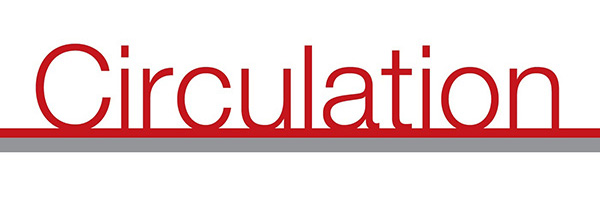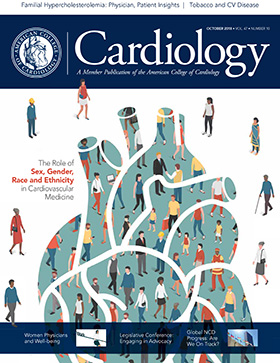Journal Wrap
The hottest research from various peer-reviewed journals – handpicked weekly by the ACC.org Editorial Board led by Kim Eagle, MD, MACC.
ATTR-ACT: Tafamidis Findings Offer Hope For Patients With ATTR-CM

Tafamidis is an effective and safe therapy for treating patients with transthyretin amyloid cardiomyopathy (ATTR-CM), based on findings from the ATTR-ACT trial presented at ESC Congress 2018 and published in the New England Journal of Medicine.
ATTR-CM – a rare, progressive and fatal disease that is either hereditary (mutations in the TTR gene) or acquired – typically presents in patients between 50 and 80 years. Currently there are no approved drugs to improve survival, which on average is three to five years after diagnosis. However, tafamidis has received orphan drug designation from the European Medicines Agency (EMA) and Fast Track designation from the U.S. Food and Drug Administration (FDA). Read More >>>
In ATTR-ACT, researchers randomized 441 patients from 48 centers in 13 countries to receive tafamidis (80 mg), tafamidis (20 mg) or placebo once a day for 30 months. The two tafamidis groups were combined (n=264) and compared with the placebo group (n=177).
Tafamidis significantly reduced the primary composite endpoint of all-cause death and cardiovascular-related hospitalization compared with placebo at 30 days. During the 30-month follow-up, 78 (29.5 percent) patients receiving tafamidis died compared with 76 (42.9 percent) receiving placebo. Rates of cardiovascular-related hospitalizations were 52.3 percent with tafamidis vs. 60.5 percent with placebo.
Regarding secondary outcomes, exercise capacity assessed with the six-minute walk test and health-related quality of life were better with tafamidis than placebo. Additionally, discontinuation of tafamidis due to treatment-related adverse events was less common in the treatment group compared with placebo.
"There are no medications specifically approved for the treatment of transthyretin amyloid cardiomyopathy," said principal investigator Claudio Rapezzi, MD. "Tafamidis improved survival and quality of life, and reduced hospitalizations, indicating that it could be an effective therapy for these patients. A submission to the regulatory authorities for marketing approval is in process as a consequence of this study."
In a related editorial, C. Cristina Quarta, MD, and Scott D. Solomon, MD, FACC, write that the ATTR-ACT findings "offer hope for patients" and "suggest new ways forward in testing therapies for new diseases."
However, they also caution that the findings raise further questions "about the mechanism of action of tafamidis, the time course of benefit, and the timing of treatment in the course of a patient's disease" and suggest additional studies "to determine whether there are important therapeutic differences between transthyretin stabilization and transthyretin knockdown."
Maurer MS, Schwartz JH, Gundapaneni B, et al. N Engl J Med 2018;379:1007-16.
SCOT-HEART: CTA May Lead to Lower Rates of Death, MI

In patients with stable chest pain, adding coronary computed tomographic angiography (CTA) to standard care lead to a significantly lower rate of the primary outcome of death from coronary heart disease (CHD) or nonfatal myocardial infarction (MI) after five years, vs. standard care alone, according to results of SCOT-HEART presented at ESC Congress 2018.
Simultaneously published in the New England Journal of Medicine, the study further demonstrated use of coronary CTA did not significantly increasing the rate of coronary angiography or coronary revascularization.
David E. Newby, MD, FACC, et al., randomly assigned 4,146 patients with stable chest pain who had been referred to a cardiology clinic for evaluation to standard care plus CTA (2,073 patients) or to standard care alone (2,073 patients). Investigations, treatments and clinical outcomes were assessed over three to seven years of follow-up.
During follow-up, patients assigned to CTA were more likely than patients assigned to standard care alone to have commenced preventive therapies (19.4 vs. 14.7 percent; odds ratio [OR], 1.40; 95 percent confidence interval [CI], 1.19-1.65) and antianginal therapies (13.2 vs. 10.7 percent; OR, 1.27; 95 percent CI, 1.05-1.54).
At five years, there was no between-group different in frequency of invasive angiography. The rate of the primary endpoint was lower in the CTA group than the standard care group (2.3 vs. 3.9 percent, respectively; hazard ratio, 0.59; 95 percent CI, 0.41-0.84; p=0.004). This difference was driven primarily by a lower rate of nonfatal MI in the CTA group.
"Our findings suggest that the use of CTA resulted in more correct diagnoses of coronary heart disease than standard care alone, which, in turn, led to the use of appropriate therapies, and this change in management resulted in fewer clinical events in the CTA group than in the standard-care group," the authors write.
Newby DE, Adamson PD, Berry C, et al. N Engl J Med 2018;Aug 25:[Epub ahead of print].
APAF-CRT: AV Junction Ablation with CRT Bests Drugs in AFib Patients with Narrow QRS

Atrioventricular (AV) junction ablation plus cardiac resynchronization therapy (CRT) is more successful than pharmacological therapy in reducing heart failure (HF) and hospitalization and improving quality of life in elderly patients with permanent atrial fibrillation (AFib) and narrow QRS, according to research presented at ESC Congress 2018 and published in the European Heart Journal.
Michele Brignole, MD, et al., randomly assigned 102 patients with severely symptomatic permanent AFib (>6 months), narrow QRS (≤110 ms) and at least one hospitalization for HF in the previous year to AV ablation and CRT (plus defibrillator according to guidelines) or to pharmacological rate-control therapy (plus defibrillator according to guidelines). The primary outcome was the first occurrence of the composite of death due to HF, hospitalization due to HF or worsening HF. Secondary clinical outcomes were total mortality, hospitalization for HF and worsening HF. Read More >>>
Over a median follow-up period of 16 months, the primary composite outcome occurred in 10 patients (20 percent) in the ablation plus CRT arm and in 20 patients (38 percent) in the drug arm. All-cause death or hospitalization for HF occurred in six patients (12 percent) receiving ablation plus CRT and 17 patients (33 percent) receiving drugs (hazard ratio [HR], 0.28; 95 percent confidence interval [CI], 0.11-0.72; p=0.008).
All-cause death occurred in two patients (4 percent) receiving ablation plus CRT and six patients (12 percent) receiving drugs (HR, 0.30; 95 percent CI, 0.06-1.50; p=0.147). Hospitalization for HF occurred in five patients (10 percent) receiving ablation plus CRT and 13 patients (25 percent) receiving drugs (HR, 0.30; 95 percent CI, 0.11-0.78; p=0.024).
Compared with the drug arm, ablation plus CRT was associated with a 36 percent decrease in the specific symptoms and physical limitations of AFib at one year of follow-up (p=0.004).
The authors believe these results "are due to the combination of the almost perfect rate regularization achieved by AV junction ablation and CRT pacing, which counteracted the adverse effects of iatrogenic AV block induced by ablation."
They add that this therapy should be offered to patients with symptomatic HF refractory to pharmacological therapy who cannot undergo catheter ablation of AFib for the maintenance of sinus rhythm or in whom ablation has failed.
Brignole M, Pokushalov E, Pentimalli F, et al. Eur Heart J 2018;Aug 26:[Epub ahead of print].
Jury Still Out on OAC Alone in AFib Plus CAD

The OAC-ALONE trial presented at TCT 2018 and published in Circulation attempted to be the first randomized controlled trial evaluating oral anticoagulation (OAC) alone without antiplatelet therapy (APT) in patients with atrial fibrillation (AFib) and stable coronary artery disease (CAD) beyond one year after coronary stenting. Unfortunately, the trial was terminated due to low patient enrollment, leaving the jury still out on the optimal antithrombotic regimen for this patient group, despite some guideline recommendations for OAC alone.
The prospective, multicenter, open-label, noninferiority trial aimed to randomize 2,000 patients over 12 months to either OAC alone or combined OAC and single APT. The primary endpoint was a composite of all-cause death, myocardial infarction (MI), stroke or systemic embolism. The secondary endpoint was a composite of primary endpoint or major bleeding using the International Society on Thrombosis and Haemostasis classification. The study was terminated early after only enrolling 696 patients in 38 months. Read More >>>
While noninferiority of OAC alone vs. combined OAC and APT was not established, of those patients enrolled the primary endpoint occurred in 54 patients (15.7 percent) in the OAC alone group and in 47 patients (13.6 percent) in the combined OAC and APT group. The major secondary endpoint occurred in 67 patients (19.5 percent) in the OAC alone group and in 67 patients (19.4 percent) in the combined OAC and APT group.
Broken down by event, MI occurred in eight patients in the OAC group, vs. four patients in the OAC and APT group, while stroke or systemic embolism occurred in 13 patients in the OAC group and 19 patients in the OAC and APT group. Major bleeding was higher in the OAC and APT group (36 patients) vs. the OAC group (27 patients).
"Because patient enrollment was prematurely terminated, the study was underpowered and inconclusive," the authors said. "Future larger studies are required to establish the optimal antithrombotic regimen in this population."
In a related editorial comment, Gilles Lemesle, MD, PhD, writes that despite the "tantalizing observations" from OAC-ALONE, the issue of which strategy should be considered as default in clinical practice (and for which patients)" is still not settled. However, she notes the findings "will be useful in planning future trials."
Matsumura-Nakano Y, Shizuta S, Komasa A, et al. Circulation 2018;Sept 24:[Epub ahead of print].
CULPRIT-SHOCK: One-Year Outcomes of Culprit-Lesion-Only vs. Multivessel PCI

The risk of death or renal-replacement therapy at 30 days and at one year in patients with acute myocardial infarction (AMI) and cardiogenic shock was lower with culprit-lesion-only PCI than with immediate multivessel PCI, based on findings from CULPRIT-SHOCK presented at ESC Congress 2018 and published in the New England Journal of Medicine.
Investigators randomly assigned 706 patients to either culprit-lesion-only PCI or immediate multivessel PCI and assessed clinical outcomes at 30 days and one year. Specific endpoints included death from any cause, recurrent MI, repeat revascularization and rehospitalization for congestive heart failure.
At 30 days, death from any cause or renal replacement therapy occurred in 45.9 percent of patients in the culprit-lesion-only group, compared with 55.4 percent in the multivessel group. (These results were previously reported at TCT 2017.) At one year, death had occurred in 50 percent of patients in the culprit-lesion-only group, compared with 56.9 percent in the multivessel group.
Additional findings showed the rate of recurrent infarction was 1.7 percent in culprit-lesion-only patients vs. 2.1 percent in multivessel patients, and a composite of death or recurrent infarction was 50.9 vs. 58.4 percent, respectively. Study investigators noted that repeat revascularization and rehospitalization for heart failure were more frequent with patients in the culprit-lesion-only group (32.3 and 5.2 percent, respectively) compared with patients in the multivessel group (9.4 and 1.2 percent, respectively).
Thiele H, Akin I, Sandri M, et al. N Engl J Med 2018;Aug 25:[Epub ahead of print].
Keywords: ACC Publications, Cardiology Magazine, Atrial Fibrillation, Atrioventricular Block, Benzoxazoles, Cardiac Resynchronization Therapy, Cardiomyopathies, Catheter Ablation, Chest Pain, Confidence Intervals, Coronary Angiography, Coronary Artery Disease, Coronary Disease, Defibrillators, Embolism, Follow-Up Studies, Heart Failure, Hemostasis, Hospitalization, Iatrogenic Disease, Infarction, Marketing, Mutation, Myocardial Infarction, Odds Ratio, Orphan Drug Production, Percutaneous Coronary Intervention, Pharmaceutical Preparations, Prealbumin, Prospective Studies, Quality of Life, Renal Replacement Therapy, Research Personnel, Shock, Cardiogenic, Stroke, Thrombosis, United States Food and Drug Administration
< Back to Listings








